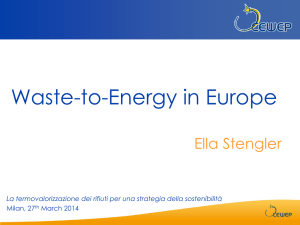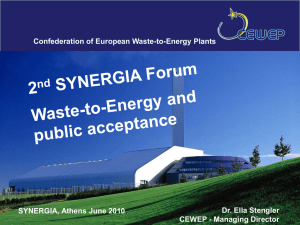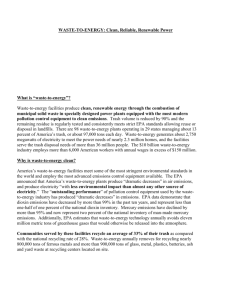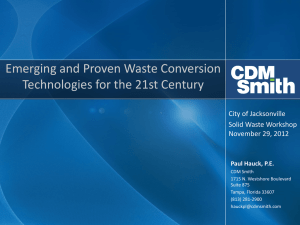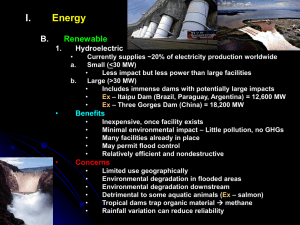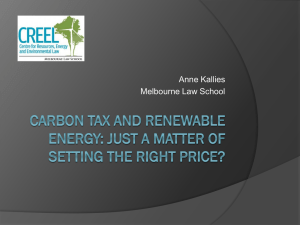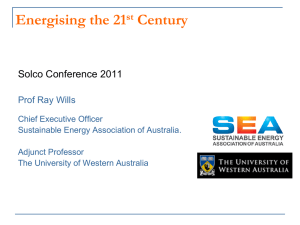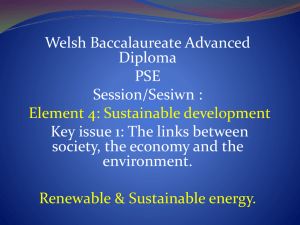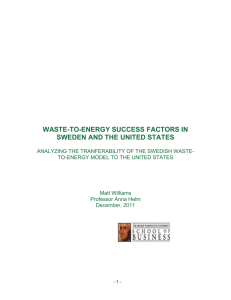Waste-to-Energy (WTE)
advertisement
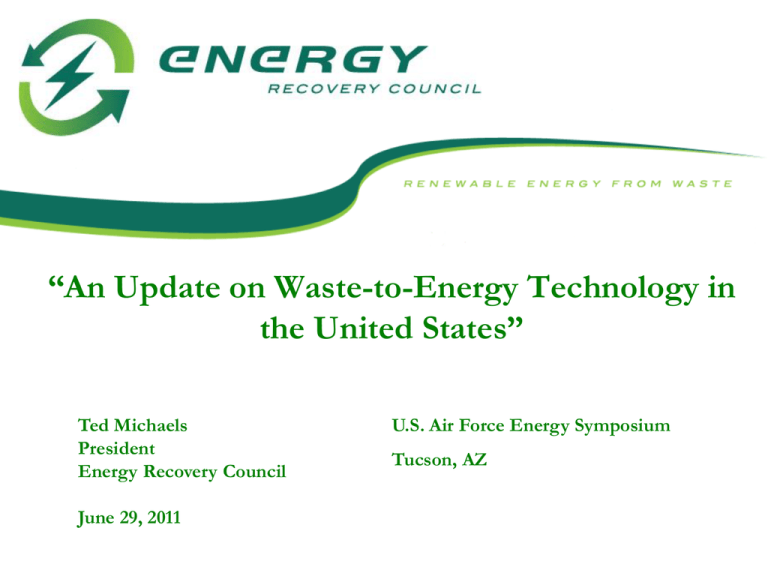
“An Update on Waste-to-Energy Technology in the United States” Ted Michaels President Energy Recovery Council June 29, 2011 U.S. Air Force Energy Symposium Tucson, AZ Outline • • • • • • • Industry Overview WTE Process Overview Life Cycle Analysis Case Studies Policy Recognition New Capacity Opportunities Summary Energy Recovery Council & Industry Overview • ERC represents companies and local governments engaged in the nation’s waste-to-energy sector. • There are 86 waste-to-energy facilities in the United States which produce clean, renewable energy through the combustion of municipal solid waste in specially designed power plants equipped with the most modern pollution control equipment to clean emissions. • Trash volume is reduced by 90% and the remaining residue is safely reused or disposed in landfills. • The 86 waste-to-energy plants in the nation have a baseload electric generation capacity of approximately 2,700 megawatts and can process more than 28 million tons of trash per year. What is Waste-to-Energy? Waste-to-Energy is a specially designed energy generation facility that uses household waste as fuel and helps solve some of society’s big challenges Municipal Solid Waste 1 ton Power: up to 750 kWh Metal: 50 lbs Ash: 10% of original volume Waste-to-Energy Playing a Significant Role Waste-to-Energy Facility Reducing the Volume of Waste & Saving Space in the Landfill while Generating Clean, Renewable Energy 13,000 KWh generated IN 100 cubic yards of waste 90% volume reduction OUT 10 cubic yards of (inert) ash Clean, Renewable Energy • U.S. EPA has stated that Waste-to-Energy “produces electricity with less environmental impact than almost any other source” • 26 States, the District of Columbia, Puerto Rico, the Northern Marianna Islands, and the federal government define Waste-to-Energy as renewable • Waste-to-Energy produces up to 750kWh per ton while landfill gas produces 65 kWh per ton • Waste-to-Energy complements other renewable sources • 24 hours per day, 7 days per week • A new 1,500 ton/day facility = 50 MW electricity Environmental Performance Waste-to-Energy U.S. EPA: “The performance of the MACT retrofit has been outstanding.” 8/10/2007 Pollutant 1990-2005% reduction Dioxin 99 Mercury 96 Cadmium 96 Lead 97 Particulate Matter 96 HCl 94 SO2 88 NOx 24 WTE & Greenhouse Gas Avoidance Waste-to-energy plants are tremendously valuable contributors in the fight against global warming. According to the U.S. EPA MSW Decision Support Tool nearly one ton of CO2 equivalent emissions are avoided for every ton of municipal solid waste handled by a waste-to-energy plant due to the following: • Avoided methane emissions from landfills. When a ton of solid waste is delivered to a wasteto-energy facility, the methane that would have been generated if it were sent to a landfill is avoided. While some of this methane could be collected and used to generate electricity, some would not be captured and would be emitted to the atmosphere. • Avoided CO2 emissions from fossil fuel combustion. When a megawatt of electricity is generated by a waste-to-energy facility, an increase in carbon dioxide emissions that would have been generated by a fossil-fuel fired power plant is avoided. • Avoided CO2 emissions from metal recycling. Waste-to-energy plants recover more than 700,000 tons of ferrous metal for recycling annually. Recycling metals saves energy and avoids CO2 emissions that would have been emitted if virgin materials were mine and new metals were manufactured, such as steel. Environmental Performance of Waste-to-Energy Climate Change 1.5 Ton CO2e / ton MSW 1.0 0.5 CO2 from the combustion of biomass not counted as an emission CO2 from the combustion of plastics counted as an emission 0.0 -0.5 -1.0 -1.5 CO2 from combustion Fossil CO2 avoided by of MSW WTE power Methane avoided by WTE WTE Life Cycle Unit Operations Net GHG factor Life Cycle Analysis of WTE & GHG “Discarded MSW is a viable energy source for electricity generation in a carbon constrained world. One notable difference between LFGTE and WTE is that the latter is capable of producing an order of magnitude more electricity from the same mass of waste. In addition, as demonstrated in this paper, there are significant differences in emissions on a mass per unit energy basis from LFGTE and WTE. On the basis of the assumptions in this paper, WTE appears to be a better option than LFGTE. If the goal is greenhouse gas reduction, then WTE should be considered as an option under U.S. renewable energy policies.” International Recognition of Waste-to-Energy as a Greenhouse Gas Reducer The World Economic Forum in its 2009 report, “Green Investing: Towards a Clean Energy Infrastructure,” identifies waste-to-energy as one of eight technologies likely to make a meaningful contribution to a future low-carbon energy system. The Eight Emerging Large-Scale Clean Energy Sectors include 1. Onshore Wind 2. Offshore Wind 3. Solar Photovoltaic (PV) 4. Solar Thermal Electricity Generation (STEG) 5. Municipal Solid Waste-to-Energy (MSW) 6. Sugar-based Ethanol 7. Cellulosic and Next Generation Biofuels 8. Geothermal Power Credits on the Voluntary Market Voluntary Carbon Standard The VCS Registry System is a custodial system for Voluntary Carbon Units (VCUs), the carbon offsets generated under the VCS Program. The VCS Registry System enables the tracking of all VCUs, from issuance to retirement, and is a key part of the VCS Program which ensures that all VCUs are real, measurable, additional, permanent, independently verified, unique and traceable. Lee County, Florida Lee County, Florida’s waste-to-energy facility is the first waste-to-energy facility in the United States to be approved under a national voluntary standard to sell offsets. Renewable Energy Credits Waste-to-energy facilities have sold renewable energy credits to the Federal Government through solicitations and to private parties who voluntarily acquire renewable energy. WTE Case Studies Eileen Berenyi of Governmental Advisory Associates conducted 4 case studies (West Palm Beach, FL; Westchester County, NY; Olmsted County, MN; Marion County, OR) for the American Chemistry Council, which are available online at http://plastics.americanchemistry.com/sustainability-recycling/energy-recovery. Highlights from the study of the Westchester Couny, NY waste-to-energy facility include: Energy Efficiencies: 700,000 tons of waste processed produces about 412,000 Mwh of electricity sold to the grid enough to service about 41,000 homes. Employment: The plant employs 66 permanent skilled workers, who contribute about $5,000,000 to the local economy annually. In addition, the facility contributes an additional $6,000,000 to the region annually through purchases of goods and services. Recycling Levels: The facility was built in 1984. In the early 1990s, the county’s recycling rate stood at 7%. By 1994, this rate had doubled to 15% and as of 2009, it stands was 41%. Metal Recovery: The facility recovers about 17,000 tons per year of ferrous metal at a value of approximately $3.4 million. Greenhouse Gas Reductions: Using the US EPA’s WARM model, one can calculate that processing 700,000 tons of waste through the WTE plant results in a net reduction of 248,000 MTCEs (Metric Tons Carbon Equivalents), which is comparable to taking about 166,500 cars off the road. Federal Legislation Current laws and legislative proposals provide recognize waste-to-energy as renewable and climate-friendly. TAX CREDITS • The American Recovery and Reinvestment Act of 2009 signed into law by President Obama extended the Section 45 renewable energy production tax credit (PTC), which includes WTE, until 12/31/2013. (ITC and Sec. 1603 grants also options) RENEWABLE (or CLEAN) ENERGY STANDARD • Last year, bills in both the House and the Senate proposed establishment of a renewable energy standard (RES or RPS) which define waste-to-energy facilities as generators of renewable energy and make them eligible to generate and sell renewable energy credits. (Waxman-Markey; Bingaman; Bingaman-Brownback; Klobuchar; Lugar). The 112th Congress has yet to take action. CAP-AND-TRADE (111th Congress) Would not require WTE facilities to be regulated under a cap-and-trade system if its fuel source was more than 95% MSW on a heat-input basis. WTE Capacity Development Companies and communities are developing or exploring WTE development across North America. Expansions of existing facilities: • Lee County, FL (completed) • Hillsborough County, FL (completed) • Olmsted County, MN (completed) • Pope-Douglas Counties, MN • Honolulu, HI Development of greenfield facilities: • Frederick County, MD • Harford County, MD • Baltimore, MD • Palm Beach County, FL • City of Los Angeles • Montgomery, NY • U.S. Virgin Islands • And others at earlier stages of consideration including Iowa, Indiana, Ohio, Wisconsin, Colorado, North Carolina, Florida, Arizona, Idaho, Puerto Rico, Massachusetts, etc. WTE Conversion Technologies Many companies/developers are exploring conversion technologies as an alternative to combustion of MSW: Gershman, Brickner & Bratton Inc in a September 2010 counted 563 Companies offering technology and/or development services: • 30 Aerobic Composting • 106 Anaerobic Digestion • 34 Ethanol Fermentation • 170 Gasification • 47 Plasma Gasification • 47 Pyrolysis • 61 WTE: mass burn, modular, and RDF • 68 Others (agglomeration, autoclave, depolymerization, thermal cracking, steam reforming, hydrolysis) Source: Gershman, Brickner & Bratton Inc. September 2010 Summary • Municipal solid waste is a homegrown renewable energy source that can contribute significantly to a renewable and climate-conscious future. • All levels of government, foreign and domestic, have recognized the benefits waste-to-energy and are shaping policies to promote. • Increased cost of compliance for fossil fuel electricity sources will make WTE more attractive in the marketplace. • The political attractiveness of developing GHG-mitigation power sources will make it easier for communities to develop WTE facilities. • The United States has a long way to go to catch up with policies in Europe that promote renewables and WTE, but momentum is building. For More Information: Ted Michaels President Energy Recovery Council 1730 Rhode Island Avenue, NW Suite 700 Washington, DC 20036 202-467-6240 tmichaels@energyrecoverycouncil.org www.energyrecoverycouncil.org
